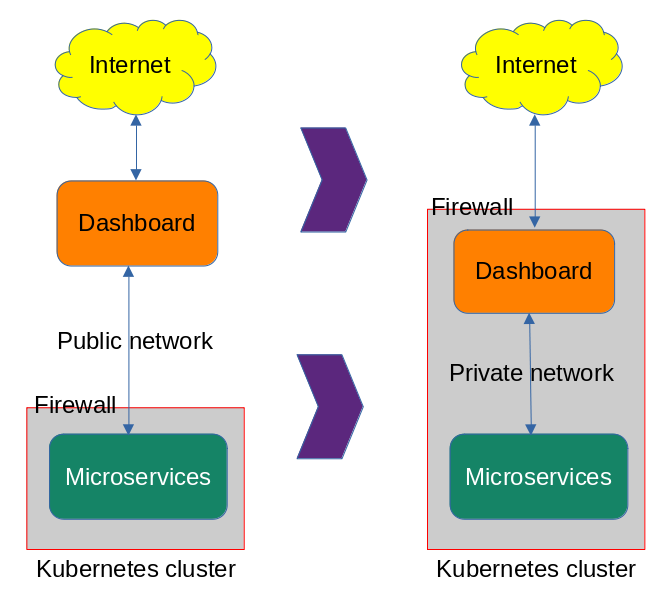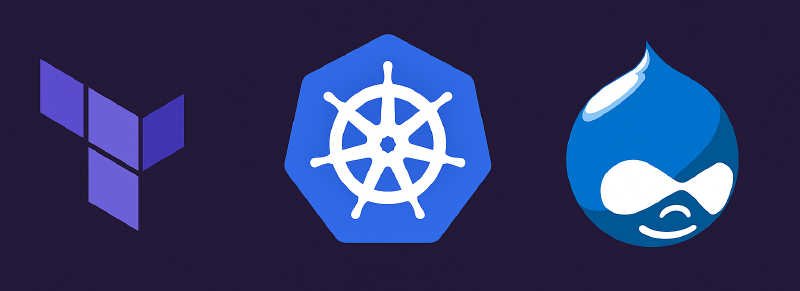This article was originally published on the BackUpScale blog.
Background
Our customer dashboard, which will soon be used for managing subscriptions to our backup service (and not just newsletters and our contact form, as we’re doing now), is built on the Drupal data management framework. Until now, we’ve been hosting it with a company that specializes in hosting very specific types of applications, like Drupal. This wasn’t working for us because our service is running in our Kubernetes cluster at a cloud service provider that specializes in managed Kubernetes hosting, which let’s us run whatever applications we want, and configure them however we need. The challenge was getting the dashboard to communicate securely with our other applications.
It needs to communicate with our back-end systems in the Kubernetes cluster to:
- send requests from customers to provision services,
- configure customer accounts, and
- receive status information from back-end services to create log entries that users can see in their accounts.
Why the old approach broke down
In order for things to work with the old set up, we’d have to:
- expose internal applications to the Internet (so the dashboard site could access them), and
- add additional layers of security to the communications to ensure privacy.
We didn’t feel as confident with this set-up as moving everything into our private Kubernetes network, which protects all of our services with a single firewall. Keeping non-public facing services within that network ensures that they’re not accessible by anyone on the greater Internet (except our staff using the company VPN), which ensures greater security and privacy for our users.
In order to make the change, we needed to be able to run a Drupal site within Kubernetes. Given that Drupal is a popular framework, and Kubernetes is a popular container orchestration system, we assumed that there would be good options for putting them together using open-source infrastructure as code (IaC) to handle the automated provisioning (we automate everything here). However, we weren’t able to find anything that could help us.
Evaluated options
We explored the following options:
- Bitnami’s Helm chart (no longer supported as of 2021)
- Jeff Geerling’s Drupal Operator (no longer supported as of early 2025)
The Bitnami Helm chart did at least one very strange thing: It was placing the Drupal code files on the persistent volume instead of placing them in the container image. We wanted the Drupal code (or at least the Composer files that build it along with any custom code) to be version controlled with Git. When we tried to work around this, they made it very difficult to make these changes.
Jeff Geerling simply stopped recommending his earlier approach (except for potentially hosting many sites on a hosting platform), and said that he currently uses his own Kubernetes primitives. So we took that idea, and expanded on it to build a fairly complete solution. Once we had something that worked for us, we believed we could make it generic enough to make it available to everyone else. So that’s what we did.

This move eliminated two Internet-facing endpoints and let us apply a single network-policy layer to all microservices. Additionally, running inside the cluster removes a public load balancer, and shrinks latency.
Meet “Drubernetes”
Because we automate all of our infrastructure with Terraform, we just released Drubernetes, a new module in the Terraform Registry, which provisions Drupal onto a generic Kubernetes cluster. It shouldn’t matter where your cluster is, who’s managing it for you, or if you’re managing it yourself on your own hardware. We wanted to provide something standardized that everyone can use and build from.
Contribute
Contributions are welcome! Please try it, and provide any feedback that you may have. The project is hosted on Gitlab.com, and any issues can be opened from the board.
As always, if you have questions or feedback, feel free to reach out. We appreciate your support and can’t wait to bring you the next chapter of BackupScale.
